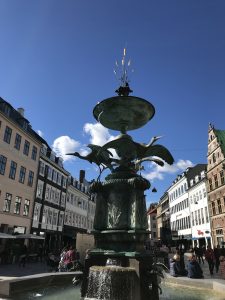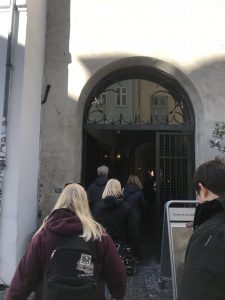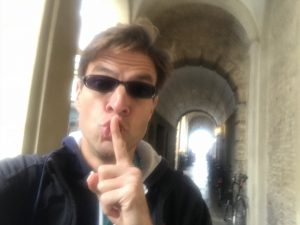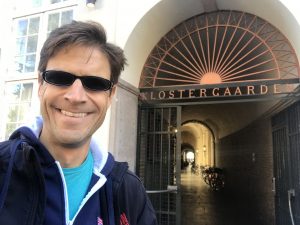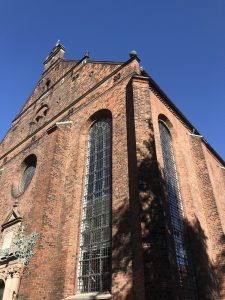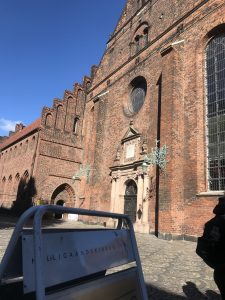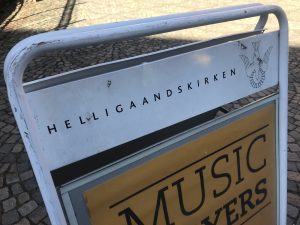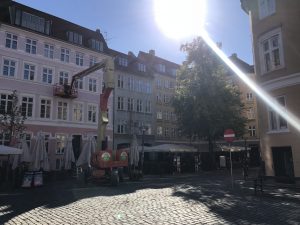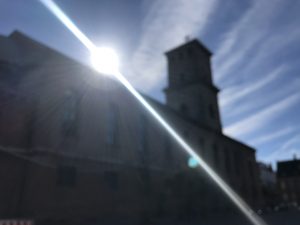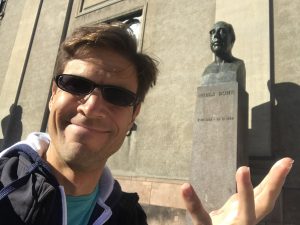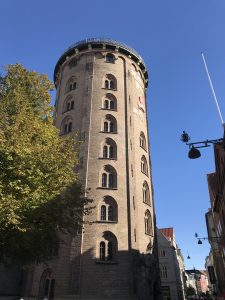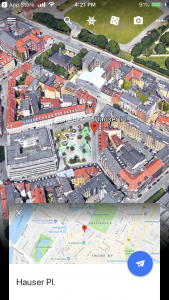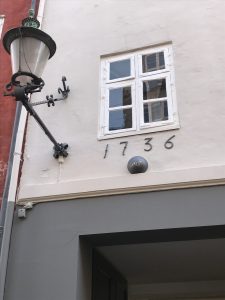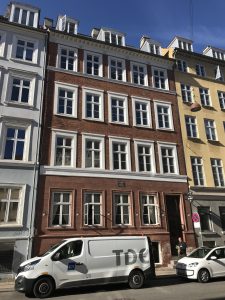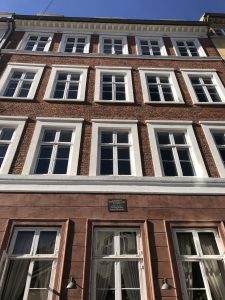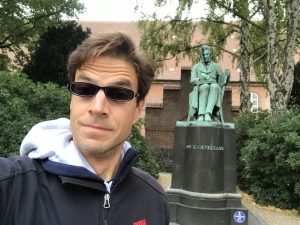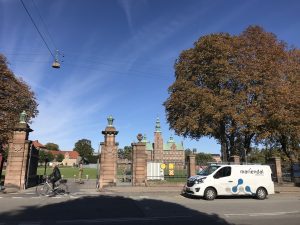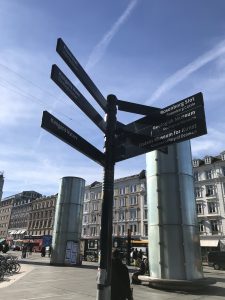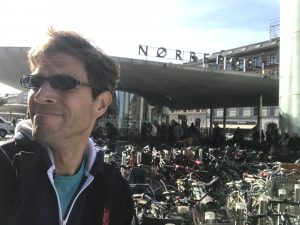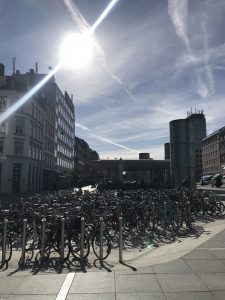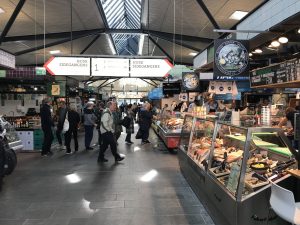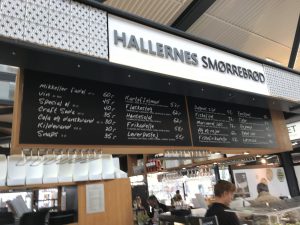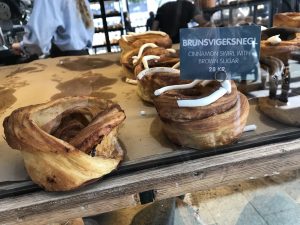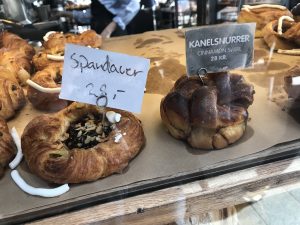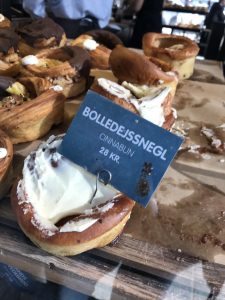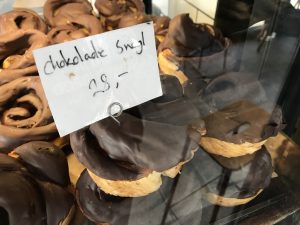The second tour of the day was a 90 minute walk to the north of Hojbro Plads with its axe-weilding Bishop Absalon. We begin at the Stork Fountain, so named because, well, there are three storks carve into it.
It actually replaced in the 1890s a rather mundane looking fountain that originated with the coronation of King Christian IV (“the builder” and probably the king most responsible for the stuff that’s endured over the centuries in this city and really took the place from a fishing town to a player on the world stage). He was 18 at the time, a real carouser and a bit of a playboy. And to mark the occasion, he had a fountain built at this spot that flowed not with water but with wine. For a full week you could just wander over and fill your jug. I once had a similar experience at the Ballade recovery walk post-Medoc Marathon. I’m not sure that’s included anywhere readily accessible on Run Kevin Run Dot Com but you might try HERE.
In the 1950s the Stork Fountain took on new significance as graduates of the midwifery colleges took a traditional photo there to mark the occasion. Since then it’s become a tradition for ALL graduates to come and get a photo at (or in) the fountain. Our guide said we should be glad we missed graduation this year as he had a tour in July when a class of mechanics graduated and were swimming in the fountain buck naked.
We took a few shortcuts through the city streets, the kind of secret passages you might find on a Clue board or in a Pac-Man maze. Our guide said even the locals sometimes don’t know about these alleys you can use to walk the hypotenuse and get to where you want to go.
***
We came to the Church of the Holy Ghost (you might know it better by its Danish name: Helligåndskirken – “skirken” by the way means church. So now you know what “helligand” means too).
It dates to the 1200s but more recently it housed the Danish resistance in WWII. As an occupied country, Denmark was a collaborative government insomuch as they didn’t stand a chance against the Nazi blitzkrieg. In fact when they were invaded at 6 AM, they had surrendered by 8 AM. One of the cells of the resistance was Holger Danske, named so after a legendary Danish knight. They held their secret meetings in this church but unfortunately toward the end of the war, they were betrayed. Raided by the Nazis, 35 members were marched into the courtyard and executed. There’s a monument to them and all who fought against the Nazis in that courtyard today.
***
Danish Fun Fact: LEGOs were created here by Ole Kirk Christiansen. He used to build blocks for his kids to play with and when vacuum molding came into being, he realized he could make them that way… and in order to prevent them from slipping he added the button pegs tops. He originally called them, according to our guide, “automatic binding bricks system” but the marketing crew figured “LEGO” rolled off the tongue better. It’s apparently derived from the Danish phrase leg godt, which means “play well.” Truth or mostly truth? The other fun fact was that LEGO manufactures the most tires/tyres in the world. Those wheels might be small, but they add up to a whole lot of rubber.
***
Gråbrodretorv is known in English as “gray brother square” so named after the monks who used to live there. It became a very exclusive address in the city.
And it was also home to Denmark’s greatest traitor. Towards the end of Christian IV’s reign, his son Frederick III was set to take over. But he was pretty wet behind the ears and the powerful coterie of advisors sent him off for royal finishing school to learn the ways of the monarch. In the meantime, Count Corfits Ulfeldt, the treasury executive, gave himself the title “Steward of the Realm” and ran things his way “just until Frederick was ready.” Well, Frederick comes back and Ulfeldt isn’t going to give over control. A civil war, and eventually Frederick is able to assert control. Ulfeldt is then banished from the realm for his attempt usurpation of the throne. That’s all bad enough but then he goes to Sweden (SWEDEN!). And when he did, he took most of the Danish treasury with him (didn’t anybody think to ask him for the keys to the vault back? Isn’t that pretty standard exit interview/banishment etiquette? Maybe not back then… maybe this is why it’s SOP now). Anyway, Count Ulfeldt then uses the Danish cash to fund a Swedish (SWEDISH!!) army to invade Denmark. The whole thing kinda came to a stalemate and nobody was really making much progress and eventually it all just kinda… petered out. Ulfeldt fled in disgrace and it’s believed he died in a sword fight in Rhein but nobody knows for sure. What they do know is that Ulfeldt’s wife was still in Copenhagen so they decided to punish her in his stead (that is one TERRIBLE marriage she had). For 21 years she was in solitary confinement but was a model prisoner and eventually they set her free (can 21 years be said to be eventually? I didn’t ask but wish I had). Still angry though, the Copenhagens decided to destroy Ulfeldt old mansion that was in this “gray brother square.” It became something of a hog roast and drinks here drunk and everybody got to take an axe to the building and all was kinda made right. However, they weren’t done – they took a pillar from the building and erected it in this square. It was called “The Pillar of Shame.” And for 200 years, every Copenhagenian would go past it and they’d spit on it in disgust of old Count Corfits Ulfeldt.
Eventually somebody realized this was a pretty nice neighborhood and the spitting pillar wasn’t exactly helping “sell” the place. The pillar was removed to the National Museum where it still can be found today… along with a sign that says, “Please no spitting.”
***
The highest point in Copenhagen is 16 m above sea level. So it’s a pretty flat place. But at that massive peak, we find the University of Copenhagen, founded in 1479. Sadly, it’s only the *second* oldest Scandinavian university. The Danes were beaten by two years by the Swedes. (THE SWEDES!).
The original degrees back in 1479 were either medicine, law, or philosophy. These days obviously there’s a few more. One of the famous graduates was Niels Bohr, famed for his atomic research that would later be used to help the Manhattan Project develop the atomic bomb. He… didn’t love that. But these things happen.
As a philosopher he would often argue with his friend Albert Einstein… but Einstein was rather dismissive of Bohr’s ideas, saying he might as well throw dice to decide his randomized beliefs. These days, people who support Bohr and his ideas often leave sets of dice on his gravestone.
***
The Round Tower is one of the oldest European observatories still in operation. It also has a church and library associated with it, giving it the name Trinitatis kirke, or “three trinity uses” church.
You can get to the top of the observatory for a great 360 degree panorama of the city… and indeed instead of stairs, it’s a large sloping ramp. The legend said it was because Christian IV wanted to be able to ride his horse to the top and back down; the truth is probably to make it easier to move the observatory equipment up and down. But the legend remained strong… so much so that Tsar Nicholas of Russia was familiar with the story when he visited in 1890… and wanted to ride HIS horse up to the top. Which apparently he did.
***
Next we wandered through Hauser plads, so named for a Danish diplomat of little importance but with a lot of money… hence his name is there. This square is an example of “democratic design” which has been readily popularized by Ikea (Those damn Swedes again!). The idea is that a space can be multi-use and practical for a number of groups. So here, there’s a playground for kids and underneath is the garage and support system for the Copenhagen street sweepers. Supposedly on GoogleEarth if you look down on this spot, the layout of the playground looks like a germ cell. Whether that’s for the street sweepers or the kids, our guide wasn’t sure (ZING!)
***
A little Danish military history for you here. The Danes often “punched above their weight” and hung tough, particularly against the Swedes (The Swedes!). In the Napoleonic Wars though, Denmark decided to stay neutral and just sell to all three warring factions, ya know, to be fair. The British Empire essentially took the tact that you’re either with us or against us… so they sent a fleet via the North Sea in 1801 to bombard the Danish navy. Eighty percent of the fleet was destroyed and the other 20% were stolen by the British. Supposedly to this day the military still refer to “Copenhagening” an enemy when they totally destroy their enemy’s military in a fight.
The Danish king however ordered all of the oak trees chopped down the fleet rebuilt, which happened in 1807. The British sent another fleet because the Danes apparently didn’t get the message the first time. This time they bombarded the fleet AND the city of Copenhagen. Their first shot, however, was fired and it hit the British Embassy. Not ideal. But they got their act together and took care of the Danes… but you can still find some cannonballs embedded in the buildings (made structurally safe so no need for “Watch for Falling Cannonball” signs).
Fun fact – the Danish King asked the north to chop down the trees and rebuild the navy again in 1807. They explained to the king they had already chopped everything down for the FIRST replacement fleet. He ordered them to plant more trees and let him know when they were ready. In 2005, they let Queen Margaret know that the trees were ready. A good sport about the whole thing, Queen Margaret asked for ONE tree to be chopped down and used in a bridge crossing the channel.
***
Hey, look. Kierkegaard’s house still exists.
And today when I went to the library, I saw his statue:
***
Pressed for time, we did a quick walk by of Rosenborg Palace, which was Christian IV’s home in the mid 17th Century. As Christian was a ladies’ man, our tour guide might say, ahem, it was his “playboy mansion.” ZING, ZING!
Amongst the innovations of the place, Christian had a full orchestra in the basement with pipes run through the walls all through the house. Thus, when he had visiting guests, he could tap a stone with his cane, the music would swell and blare, surround sound style, blowing his guests’ minds.
He also used the pipes as a telephone where only he knew where the “extension” outlets were… so he could place a “call” throughout the palace and be heard when and where he wanted.
There’s also a super gross thing but I’m cutting that for now. Google it if you want to know – it’s about a spiral staircase.
***
The final two “sights” are more modern day logistical points of interest.
Nørreport Station is the busiest transit station in Denmark and I think Scandanaivia, which is really saying something. Almost 200,000 people pass through it each day. It’s about as crowded as it got in Copenhagen and I, who suffer from crowd-o-phobia, could still manage okay. Amidst the station are large sunken bike racks. These were built with a democratic design function. The sewers in Copenhagen aren’t quite up to the task of modern needs so when there’s a massive cloud burst heavy rain storm that is happening more and more thanks to climate change (which is real by the way… and that’s me and my guide, and Norway, and a lot of other people’s view based on science and facts). Anyway, as a tiny part of the strategy, they can actually shut off the drains in the sunken bike parks thus containing pools of water and systematically controlling the drainage of flash-flooding large amounts of water into the sewer.
And the final stop was Torvehallern, a marketplace of food, sweets, and coffee. I think I gained five pounds just taking these photos:

